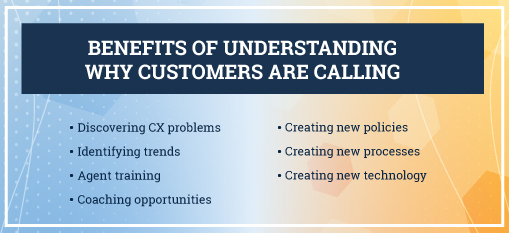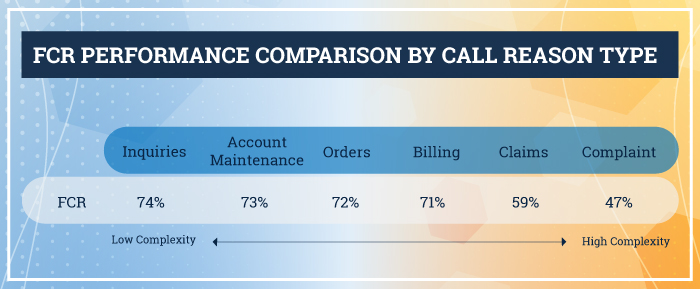What Is the Problem With Understanding the Call Reason?
SQM Group's Customer Experience (CX) research shows that less than 50% of call centers completely agree that they can identify their CX's biggest problem. Furthermore, a call center problem we see frequently is the lack of a holistic and accurate understanding of the main reasons why customers call. However, to improve CX, call centers need to understand the main reason customers call them.
Most call centers think they understand the main reasons customers are calling them but often fail to view it from a customer's point of view. Therefore, many call centers do not have an accurate and deep (e.g., customer and company perspective) understanding of why customers are calling them. SQM Group's research shows there can be a big disconnect between what customers say they called the call center for versus what an agent tagged the call reason to be.
For example, an agent tagged the call reason as a billing issue (tier 1), and the customer was wrong about how they interpreted the bill (tier 2). But, on the other hand, from a customer perspective, they called about a high bill (tier 1) that was confusing to interpret the bill charges (tier 2). As a result, in this case, the customer thinks the bill is high and confusing, which is different than how the agent tagged it as a billing issue, and the customer is wrong about the interpretation.
Why Understanding the Call Reason Is Important?
A good starting point for many call centers to improve their operating efficiency and effectiveness is an accurate and holistic understanding of why customers call them. Generally speaking, most call centers recognize the importance of why customers are calling.
However, in many cases, there is an opportunity to be more accurate and holistic in understanding the call reasons can help quantify the data from a broader perspective.
Moreover, the benefits of understanding why customers are calling include discovering CX problems, identifying trends, agent training and coaching opportunities, and creating new policies, processes, and technology. Furthermore, capturing the call reason for every customer call will provide real-time insights into service level and call abandonment issues on any given day to take the necessary action.

In addition, understanding and tagging the call reason allows a call center to accurately measure First Call Resolution (FCR) performance comparison by call reason. For example, SQM's FCR research data shows orders with the highest FCR at 75%, inquiries at 74%, account maintenance at 71%, billing at 68%, technical at 63%, claims at 60%, and complaints with the lowest FCR at 47%.
For many call centers, inquiries, account maintenance, and orders have low to moderate call type complexity and, therefore, have higher than average FCR performance. Conversely, billing, claims, and complaint call types have moderate to high call complexity and, therefore, have lower-than-average FCR performance. Understanding FCR by call reason allows a call center to prioritize call reason types to improve CX.

Solution Methods and Tips for Understanding Why Customers Are Calling
The following are methods and solution tips for understanding why customers call from a customer and agent perspective. These solution tips are considered best practices for deeply understanding customer call reasons. In addition, we will share the pros and cons of each method.
Method 1: Agent Determines Call Reason and Tags In the CRM System
Agents determine the call reason, and tags in the CRM system are the most common method for understanding why customers are calling. Your agents are an excellent source for determining call reasons and tagging reasons in the CRM system because they are the ones that handle the calls. Moreover, they are the ones that ask customers why they are calling. The call reason agent tags can help quantify and provide an accurate understanding of customers' main reasons, but they can be skewed towards a company perspective.
At SQM, we have helped leading North American call centers with their tagging practices for capturing call type reasons and repeat call reasons for over 25 years. Based on our tagging call experience, we have provided tips for ensuring calls are tagged accurately at the agent level. So let's get started with tips for agent tagging call reasons:
- Agents must be trained, coached, and monitored for understanding and tagging call reasons. We highly recommend that call centers measure an agent's ability to understand and tag call reasons via their quality assurance program.
- Use a call type reason two-tier tagging system where tier 1 (e.g., billing) is the high-level tag, and tier 2 (e.g., accuracy, clarity, frequency, etc.) is a more detailed tag. It is common for tier 1 to have 5 to 10 call reason tags and tier 2 to have 10 to 25 call reason tags. Some calls may require multiple tags because the customer called with two or more call reasons.
- It is essential not to use too many call reason tags because it will make it difficult for agents to choose a call reason tag and negatively impact the accuracy. For all call reasons, tag names should be in the same language that customers use to describe their reason for calling. Also, this approach can be helpful when compared to post-call surveys call reason data.
- It can also be helpful to tag the customer's emotions (e.g., happy, good, ok, upset and angry) to provide additional insights into the customer experience with a specific call reason.
- Furthermore, if a call is due to a previous call that did not resolve the customer's reason, it can be helpful for agents to tag the reason the customer needed to call back. This might require additional training and more seasoned agents to accurately tag repeat call reasons.
- Use a repeat calls two-tier tagging system where tier 1 (e.g., agent call handling) is the high-level tag, and tier 2 (e.g., didn't call back, lacked authority, no confidence in agent, rude, not helpful, or caring) is a more detailed tag. It is common for tier 1 to have 10 to 15 repeat call reason tags and tier 2 to have up to 50 repeat call reason tags.
- It might be possible to use speech analytics AI to tag call-type reasons and repeat calls versus the agent. However, if you decide to use AI, we recommend using agents for validating the accuracy of the AI call-type reasons and repeating call tagging.
PROS:
- The ability to understand why customers call
- Ability to quantify call type reasons and repeat call reasons
- Determine opportunities for improving FCR and Csat
- Real-time insights into service level and call abandonment issues
CONS:
- Having agents tag call-type reasons and repeat calls can lead to inaccurate results if they are not adequately trained, monitored, and coached
- It can increase call length and increase agent labor costs
- If you only do agent tagging to understand why customers call, it can be a skewed perspective
- There can be a big disconnect between how agents and customers view the call reason
Method 2: Use Post-Call Survey to Determine Call Reason and Tag In Your CXM System
Another excellent method for understanding why customers are calling is conducting post-call surveys. For example, based on a post-call survey asking the customer why they called and using predefined call reasons choices (e.g., orders, service, claims, technical, billing, etc.) for them to choose the right call reason.
At SQM, we have many clients that use a survey question to ask customers why they called with predefined rating choices and also provide us with how the agent tagged the call reason. The two approaches offer a holistic understanding of why customers call that can be used to compare and contrast the customer versus the agent perspective of the call reason. So let's get started with tips for using a post-call survey method for tagging call reasons:
- The post-call survey design needs to include a question asking customers why they called and using call reason choices. An alternative approach is to use an open-ended question to ask customers why they called, and the survey interviewer tags the call reason based on predefined call reason tags. Either approach must be tested to ensure accuracy, which can be done by evaluating the call recording via QA evaluators.
- Similar to method 1, use a call type reason two-tier tagging system where tier 1 (e.g., billing) is the high-level tag, and tier 2 (e.g., accuracy, clarity, frequency, etc.) is a more detailed tag. It is common for tier 1 to have 5 to 10 call-type reason tags and tier 2 to have 10 to 25 call-reason tags. Some calls may require multiple tags because the customer called with two or more call-type reasons.
- It is essential to emphasize that it has been our experience comparing method 1 (agent tagging) to method 2 (post-call survey); the Csat by call type reason can be significantly different. However, both ways can be valuable for providing CX insights, and we recommend using both methods.
- An alternative to methods 1 and 2 is to have a quality assurance (QA) evaluator determine why a customer called when assessing the call recording. The QA evaluator can use a call type reason two-tier tagging system similar to what is used in a post-call survey method.
PROS:
- The use of the voice of the customer to determine the call type reason is a customer-centric approach
- An outside-in approach for understanding call-type reasons to assist in developing new people, processes, and technology to improve CX
- Proven track record for helping call centers improve CX. Also, you can standardize the identification of call reasons for benchmarking CX to other call centers
- Ability to compare and contrast to agent call reason tagging for holistic CX insights
CONS:
- Additional cost for conducting post-call surveying to understand why customers are calling
- The use of multiple methods can provide conflicting messages
- Many agents prefer their assessment of the call type reason versus the customer's viewpoint of the call type reason
- In some cases, the agent is a better judge of understanding the call type reason than the customer
Quick Related Links
First Call Resolution Comprehensive Guide Customer Satisfaction Comprehensive Guide Agent Coaching Customer Quality Assurance Good to Great Customer Service

